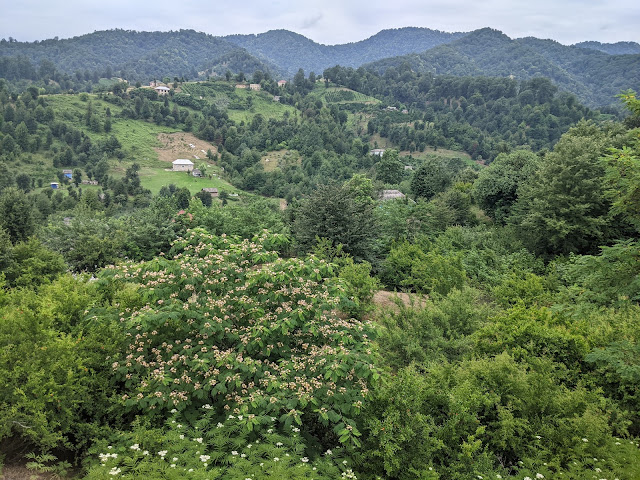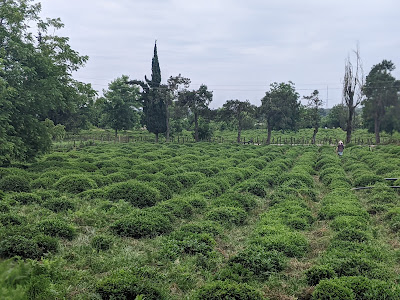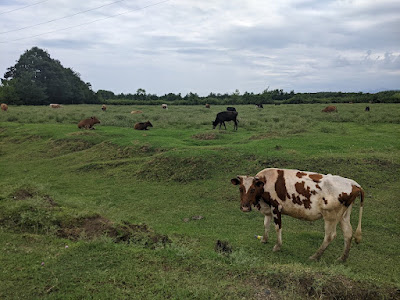Still in Azerbaijan and totally enchanted by the remarkable diversity of topography and climate, including humid subtropical, Mediterranean, semi-arid, and alpine climates, a perfect place for a floraphile :) During this post we'll take a look the beautiful region of Lankaran in the South East, from the wild forests of Hirkan National Park, the local horticultural practices in the lowlands and a walk along the Iranian border.
In stark contrast to the semi-arid desserts that surround Baku, Lankaran, just a few hours drive South is chlorophyllically opulent. A Köppen climate classification: Csa indicates cool, wet winters and very warm, partially dry/highly humid summers. The forests are absolutely beautiful and home to wild animals, long since hunted to extinction in the majority of temperate forests of the world, including the Persian leopard - Panthera pardus tulliana. You can see these magnificent creatures up close at Baku Zoo and small numbers are reported to live in the Hirkan National Park.
Hirkan National Park is located in western part of the Talysh Mountains, the mountain range that stretches into Iran around the southern coast of the Caspian Sea and drops down onto the Iranian Plateau. As mentioned above the mountain range is home to a small population of Persian leopard - Panthera pardus tulliana an endangered species with only an estimated 1,000-2,500 left in the wild.
The leopards are solitary animals, and they are difficult to spot in the wild. However, there are a number of camera traps in the park that have captured images of the leopards. They are an important part of the ecosystem helping to keep the population of deer and other animals in check which in turn keeps the browsing pressure off the plants.
To get to the Hirkan National Park you can head to a small village called Sim. Google maps will give you a route that leads you into some off road tracks through lowland villages and eventually to a steep dip with a river at the bottom, that would be possible with a short wheel base, lifted 4x4 but is not at all possible with a car (which is what I had). Google maps is not that great in relatively unchartered territory btw but fortunately asking locals for directions works as well as it ever has. Basically, head to Sim via Sipiapart and you'll find the way. You'll still end up on a offroad track but it's doable in a car all the way to Sim. As you enter the Village of Sim there is a majestic stand of Juglans regia - Persian Walnut surrounded by huge mossy boulders.
The valley rivers on the way are incredibly beautiful in this area and often you'll find restaurants with tables built into the mountainside and piers extending into the river. Every restaurant I tried served excellent food with local produce. On that note, the restaurant at Khan Lankaran Hotel, on the outskirts of the city Lankaran, offers an outstanding selection of Azerbaijan food and is a cozy spot to enjoy a breakfast, lunch or dinner.
When you arrive in Sim it's a beautiful 40 minute walk to Sim waterfall that leads through various small holdings of the villages and some incredibly diverse forests. The trees on the high ground and in the forest surrounding the waterfall are Acer spp. that are endemic to this region, Cappadocian maple - Acer cappadocicum and Velvet Maple - Acer velutinum
Welcome to our Online Store where you can find Forest Garden/ Permaculture plants, seeds, bulbs and Polyculture multi-packs along with digital goods and services such as Online Courses, Webinars and eBooks. We hope you enjoy the store and find something you like. It's your purchases that keep our Project going! Enter Our Store Here
It was also really interesting to see the local horticulture in the lowlands that includes orchards of Citrus spp. as well as small orchards of a plant previously unknown to me in person, Feijoa sellowiana - Pineapple Guava from the myrtle family, Myrtaceae. It is native to the highlands of southern Brazil, eastern Paraguay, Uruguay, northern Argentina, and Colombia. Lankaran is one of the few areas of Azerbajain where this plant can grow, being a subtropical region.
Support Our Project
If you appreciate the work we are doing you can show your support in several ways.
Become a member of the Polyculture Project by subscribing to our Substack
Make a purchase of plants or seeds from our nursery or Online Store
Consider joining us for one of our Courses or Online Courses
Comment, like, and share our content on social media.
Make a direct donation via PayPal to balkanecologyproject@gmail.com
If you appreciate the work we are doing you can show your support in several ways.
Become a member of the Polyculture Project by subscribing to our Substack
Make a purchase of plants or seeds from our nursery or Online Store
Consider joining us for one of our Courses or Online Courses
Comment, like, and share our content on social media.
Make a direct donation via PayPal to balkanecologyproject@gmail.com




















.jpg)
.jpg)






No comments:
Post a Comment